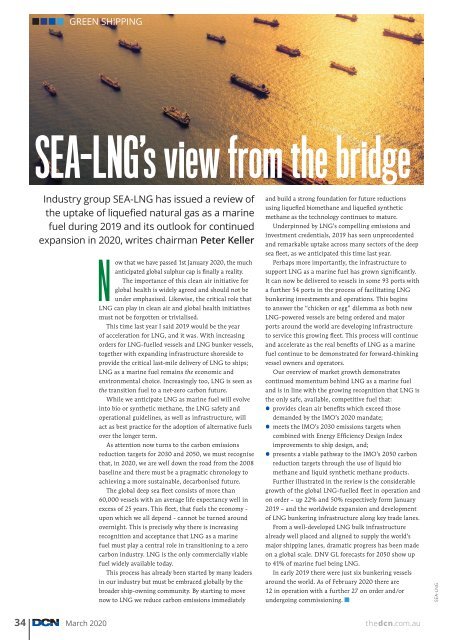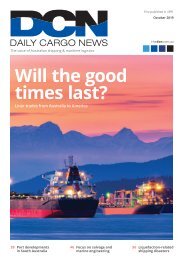DCN March Edition 2020
Create successful ePaper yourself
Turn your PDF publications into a flip-book with our unique Google optimized e-Paper software.
GREEN SHIPPING<br />
SEA-LNG’s view from the bridge<br />
Industry group SEA-LNG has issued a review of<br />
the uptake of liquefied natural gas as a marine<br />
fuel during 2019 and its outlook for continued<br />
expansion in <strong>2020</strong>, writes chairman Peter Keller<br />
Now that we have passed 1st January <strong>2020</strong>, the much<br />
anticipated global sulphur cap is finally a reality.<br />
The importance of this clean air initiative for<br />
global health is widely agreed and should not be<br />
under emphasised. Likewise, the critical role that<br />
LNG can play in clean air and global health initiatives<br />
must not be forgotten or trivialised.<br />
This time last year I said 2019 would be the year<br />
of acceleration for LNG, and it was. With increasing<br />
orders for LNG-fuelled vessels and LNG bunker vessels,<br />
together with expanding infrastructure shoreside to<br />
provide the critical last-mile delivery of LNG to ships;<br />
LNG as a marine fuel remains the economic and<br />
environmental choice. Increasingly too, LNG is seen as<br />
the transition fuel to a net-zero carbon future.<br />
While we anticipate LNG as marine fuel will evolve<br />
into bio or synthetic methane, the LNG safety and<br />
operational guidelines, as well as infrastructure, will<br />
act as best practice for the adoption of alternative fuels<br />
over the longer term.<br />
As attention now turns to the carbon emissions<br />
reduction targets for 2030 and 2050, we must recognise<br />
that, in <strong>2020</strong>, we are well down the road from the 2008<br />
baseline and there must be a pragmatic chronology to<br />
achieving a more sustainable, decarbonised future.<br />
The global deep sea fleet consists of more than<br />
60,000 vessels with an average life expectancy well in<br />
excess of 25 years. This fleet, that fuels the economy -<br />
upon which we all depend - cannot be turned around<br />
overnight. This is precisely why there is increasing<br />
recognition and acceptance that LNG as a marine<br />
fuel must play a central role in transitioning to a zero<br />
carbon industry. LNG is the only commercially viable<br />
fuel widely available today.<br />
This process has already been started by many leaders<br />
in our industry but must be embraced globally by the<br />
broader ship-owning community. By starting to move<br />
now to LNG we reduce carbon emissions immediately<br />
and build a strong foundation for future reductions<br />
using liquefied biomethane and liquefied synthetic<br />
methane as the technology continues to mature.<br />
Underpinned by LNG’s compelling emissions and<br />
investment credentials, 2019 has seen unprecedented<br />
and remarkable uptake across many sectors of the deep<br />
sea fleet, as we anticipated this time last year.<br />
Perhaps more importantly, the infrastructure to<br />
support LNG as a marine fuel has grown significantly.<br />
It can now be delivered to vessels in some 93 ports with<br />
a further 54 ports in the process of facilitating LNG<br />
bunkering investments and operations. This begins<br />
to answer the “chicken or egg” dilemma as both new<br />
LNG-powered vessels are being ordered and major<br />
ports around the world are developing infrastructure<br />
to service this growing fleet. This process will continue<br />
and accelerate as the real benefits of LNG as a marine<br />
fuel continue to be demonstrated for forward-thinking<br />
vessel owners and operators.<br />
Our overview of market growth demonstrates<br />
continued momentum behind LNG as a marine fuel<br />
and is in line with the growing recognition that LNG is<br />
the only safe, available, competitive fuel that:<br />
• provides clean air benefits which exceed those<br />
demanded by the IMO’s <strong>2020</strong> mandate;<br />
• meets the IMO’s 2030 emissions targets when<br />
combined with Energy Efficiency Design Index<br />
improvements to ship design, and;<br />
• presents a viable pathway to the IMO’s 2050 carbon<br />
reduction targets through the use of liquid bio<br />
methane and liquid synthetic methane products.<br />
Further illustrated in the review is the considerable<br />
growth of the global LNG-fuelled fleet in operation and<br />
on order – up 22% and 50% respectively form January<br />
2019 – and the worldwide expansion and development<br />
of LNG bunkering infrastructure along key trade lanes.<br />
From a well-developed LNG bulk infrastructure<br />
already well placed and aligned to supply the world’s<br />
major shipping lanes, dramatic progress has been made<br />
on a global scale. DNV GL forecasts for 2050 show up<br />
to 41% of marine fuel being LNG.<br />
In early 2019 there were just six bunkering vessels<br />
around the world. As of February <strong>2020</strong> there are<br />
12 in operation with a further 27 on order and/or<br />
undergoing commissioning.<br />
SEA-LNG<br />
34 <strong>March</strong> <strong>2020</strong><br />
thedcn.com.au
















